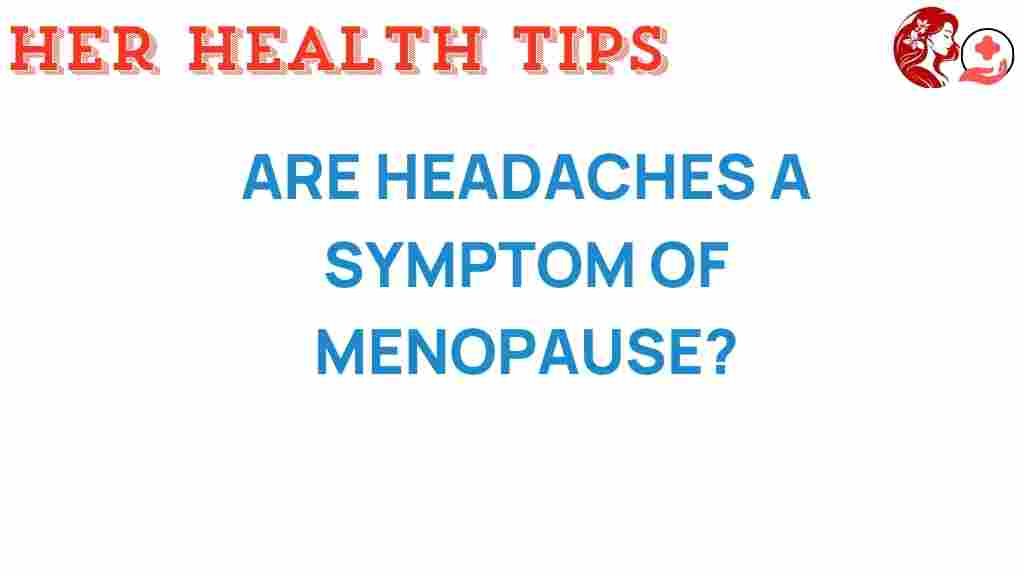Are Headaches a Hidden Symptom of Menopause?
Menopause marks a significant transition in a woman’s life, often accompanied by various symptoms that can disrupt daily activities and overall well-being. One symptom that many women may overlook is headaches. This article aims to unveil the connection between headaches and menopause, emphasizing the importance of awareness in women’s health.
The Link Between Headaches and Hormonal Changes
As women approach menopause, their bodies undergo a series of hormonal changes, primarily the decline in estrogen and progesterone levels. These hormonal fluctuations can lead to various symptoms, including:
- Hot flashes
- Night sweats
- Mood swings
- Weight gain
- Headaches
Headaches, particularly migraines, can be exacerbated by these hormonal changes. Research indicates that many women experience a change in their headache patterns during menopause, including an increase in headache frequency and intensity.
Understanding Headaches During Menopause
Headaches experienced during menopause can vary in type and severity. Here are some common types of headaches that may be linked to this transitional phase:
- Tension Headaches: Often caused by stress and tension, these headaches can become more frequent as women navigate the emotional and physical challenges of menopause.
- Migraine Headaches: Many women report changes in their migraine patterns during menopause. Some may experience fewer migraines, while others may see an increase in frequency and severity.
- Hormonal Headaches: These are often tied to fluctuations in estrogen levels. As estrogen drops during menopause, headaches may become more common.
To effectively address headaches that may be related to menopause, it’s essential to identify the symptoms. Common symptoms include:
- Pulsating or throbbing pain, typically on one side of the head
- Nausea or vomiting
- Sensitivity to light and sound
- Tightness or pressure across the forehead or back of the head and neck
- Visual disturbances (in the case of migraines)
If you experience any of these symptoms alongside other menopause symptoms, it may be worth discussing with your healthcare provider.
Step-by-Step Process to Manage and Treat Headaches During Menopause
Managing headaches during menopause involves a combination of lifestyle changes, medical treatments, and alternative therapies. Here’s a step-by-step process to help alleviate headaches:
Step 1: Keep a Headache Diary
Start by tracking your headaches. Note the:
- Date and time of each headache
- Duration and intensity
- Possible triggers (food, stress, hormonal changes)
- Relief methods used
This diary can provide valuable insights for you and your healthcare provider to identify patterns and triggers.
Step 2: Lifestyle Modifications
Consider making the following lifestyle changes to improve your overall well-being and reduce headache occurrences:
- Stay Hydrated: Dehydration can lead to headaches. Aim for at least 8 glasses of water a day.
- Eat Regularly: Low blood sugar levels can trigger headaches. Regular, balanced meals can help maintain stable blood sugar.
- Manage Stress: Incorporate stress-reducing techniques like yoga, meditation, or deep breathing exercises.
- Get Enough Sleep: Establish a consistent sleep schedule and aim for 7-9 hours of sleep each night.
Step 3: Medical Treatments
If lifestyle changes aren’t enough, consult your healthcare provider for potential medical treatments, which may include:
- Over-the-Counter Pain Relievers: Non-prescription medications like ibuprofen or acetaminophen may help alleviate headache pain.
- Prescription Medications: In some cases, doctors may prescribe medications specifically for migraines or hormonal treatments that stabilize estrogen levels.
- Hormone Replacement Therapy (HRT): For some women, HRT can help alleviate headaches by stabilizing hormone levels.
Step 4: Alternative Therapies
Many women find relief through alternative therapies. Consider exploring:
- Acupuncture: Some studies suggest that acupuncture may help reduce the frequency and severity of headaches.
- Chiropractic Care: Chiropractic adjustments may help relieve tension headaches.
- Herbal Supplements: Supplements like butterbur and feverfew have been shown to reduce migraine frequency, but consult your doctor before starting any new supplement.
Troubleshooting Common Headache Triggers
Understanding common headache triggers can help you avoid them and improve your quality of life. Here are some common triggers to be aware of:
- Dietary Choices: Certain foods, such as aged cheeses, processed meats, and artificial sweeteners, may trigger headaches in some individuals. Keep track of your diet and identify any culprits.
- Caffeine: While caffeine can help relieve headaches for some, too much or withdrawal from caffeine can lead to headaches. Monitor your caffeine intake and adjust accordingly.
- Environmental Factors: Bright lights, strong odors, and loud sounds can trigger headaches. Create a calm and soothing environment to minimize these triggers.
- Hormonal Fluctuations: Pay attention to your menstrual cycle and any changes in headache frequency or severity. Hormonal birth control can also impact headaches.
Raising Awareness About Headaches and Menopause
It’s crucial to raise awareness about the connection between headaches and menopause. Many women may not realize that their headaches are linked to hormonal changes. Education can empower women to take charge of their health and seek the appropriate care.
Women should feel encouraged to discuss any concerning symptoms with their healthcare provider. Regular check-ups and open conversations about health can lead to better management of menopause-related symptoms.
Conclusion
Headaches can indeed be a hidden symptom of menopause, often overlooked in the broader discussion of women’s health. As hormonal changes take place, it’s essential to stay aware of how these changes can affect overall well-being, including headache patterns.
By keeping a headache diary, making lifestyle modifications, exploring medical treatments, and considering alternative therapies, women can effectively manage headaches during this transitional phase. Awareness and proactive management can improve quality of life during menopause.
For more resources on women’s health and menopause, visit WomensHealth.gov. If you are experiencing severe headaches or any other symptoms, consult with your healthcare provider for tailored advice and treatment options.
Embrace this life transition with knowledge and support, understanding that you are not alone in your journey. Let’s foster a community that prioritizes awareness and well-being for all women.
This article is in the category Reproductive and created by HerHealthTips Team
